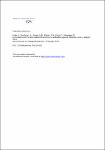Generation and characterisation of monoclonal antibodies against influenza virus A, subtype H5N1
Linke, Sonja
Neubauer, Katrin
Dorner, Martin
Dorner, Brigitte
Pauli, Georg
Schweiger, Brunhilde
The emergence of highly pathogenic avian influenza A virus (HPAIV) subtype H5N1 in 1997 has since resulted in large outbreaks in poultry and in transmission from poultry to humans, mostly in southeast Asia, but also in several European countries. Effective diagnosis and control measures are essential for the management of HPAIV infections. To develop a rapid diagnostic test, a panel of murine monoclonal antibodies (mAbs) against influenza virus A subtype H5 was generated. Eleven mAbs were produced and characterised according to their reactivity by indirect and sandwich ELISA and western blotting against different H5 subtypes representing past and viruses currently circulating. Ten out of 11 mAbs reacted strongly with the haemagglutinin (HA) protein of H5 viruses, whereas one mAb reacted with the M1 protein. Targeted HA protein epitopes seemed to be conformational. One hybridoma clone binds to a linear epitope of the M1 protein. One specific mAb reacts with HPAIV H5 in the immunofluorescence test, and two antibodies neutralised H5 viruses. On the basis of the results, the set of seven mAbs is appropriate for developing diagnostic tests. With the generated mAbs, a sandwich ELISA was developed recognising all H5N1 strains tested but no other influenza viruses. With this ELISA, as little as 0.005 HA units or 0.1 ng/ml H5N1 was detected, surpassing other ELISA tests. The novel reagents have the potential to improve significantly available rapid antigen detection systems.
Dateien zu dieser Publikation
Keine Lizenzangabe

